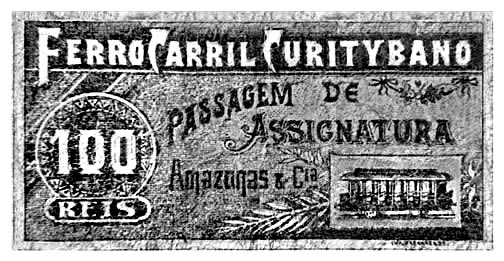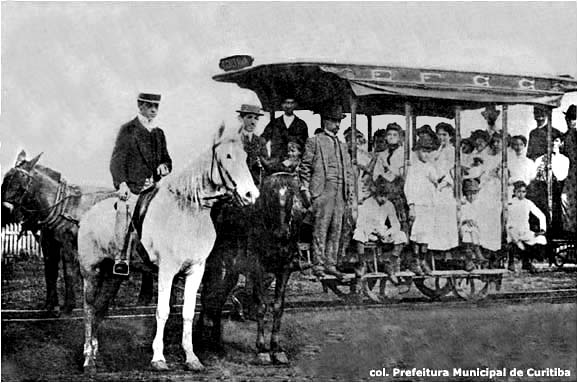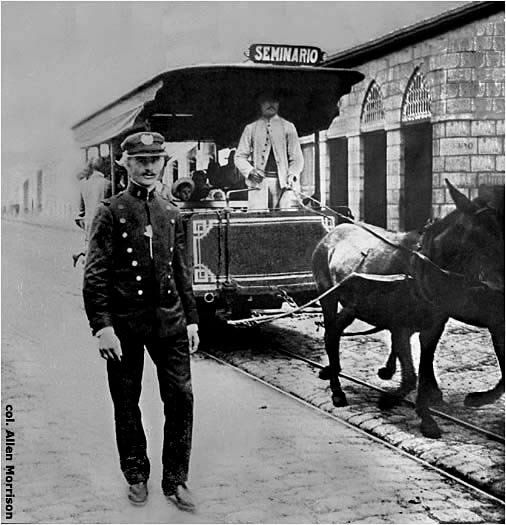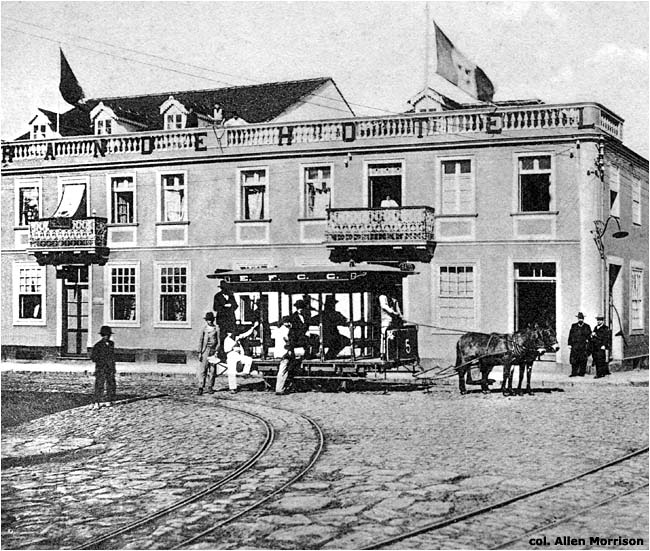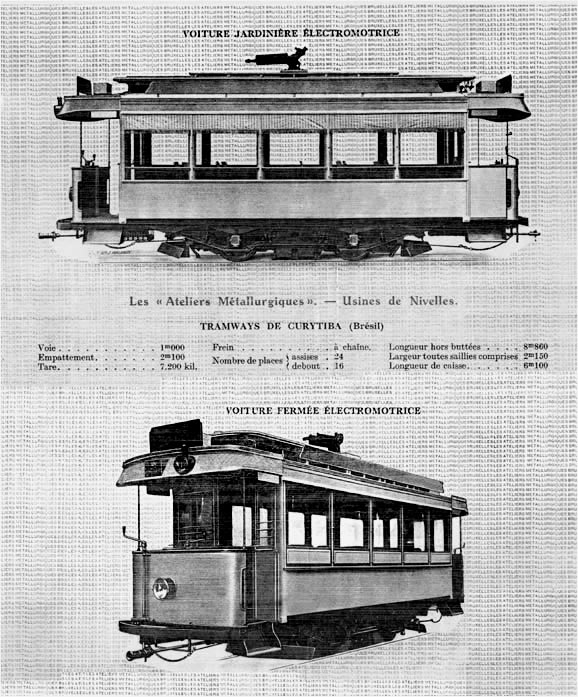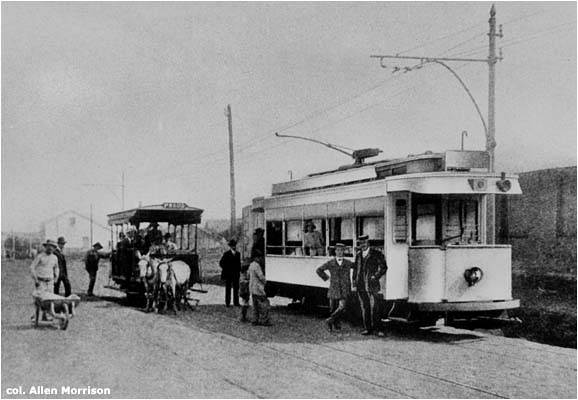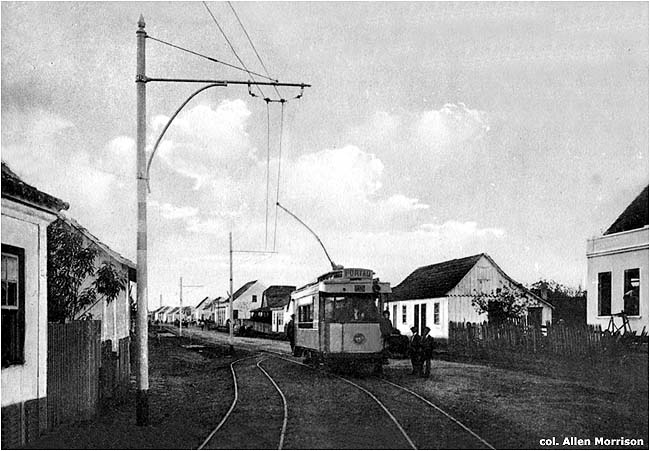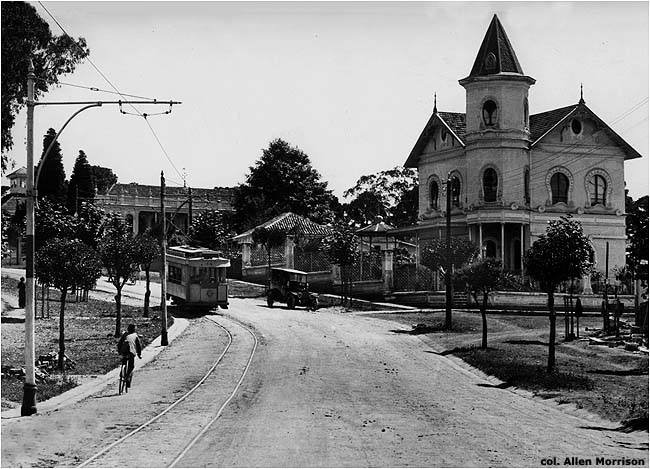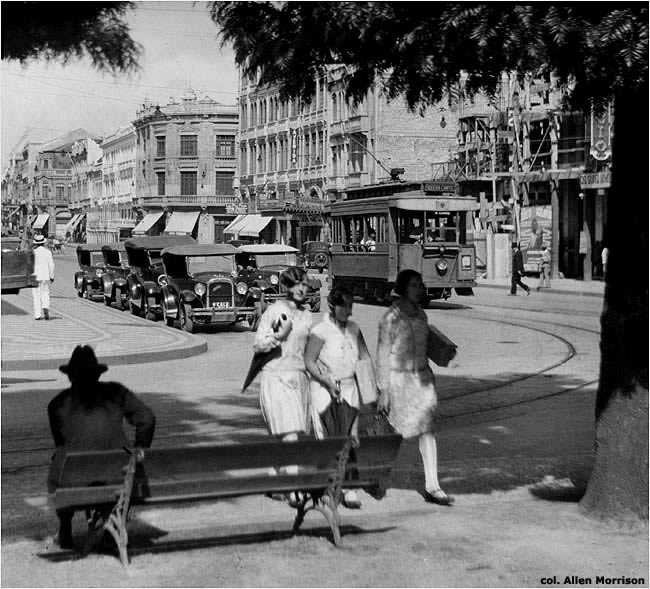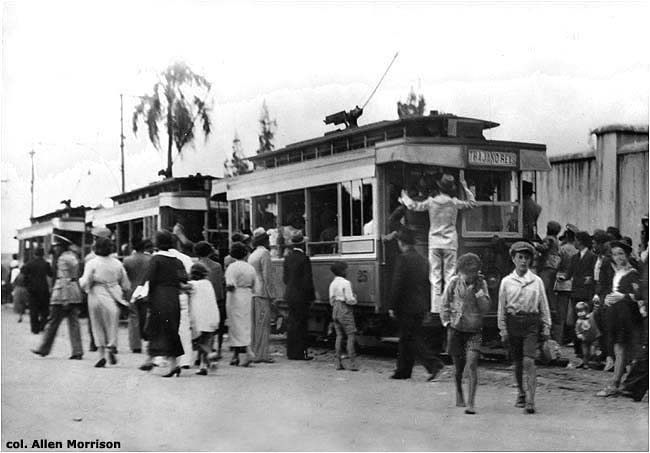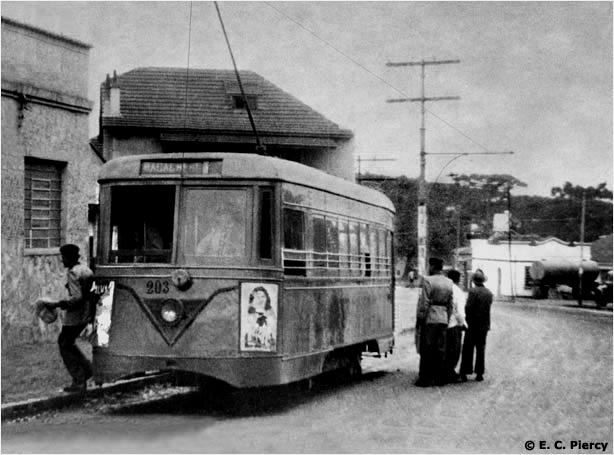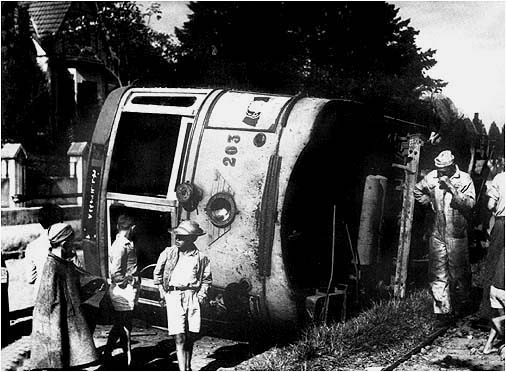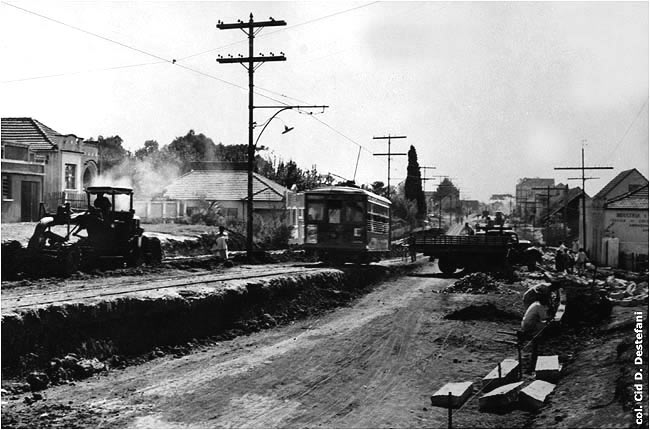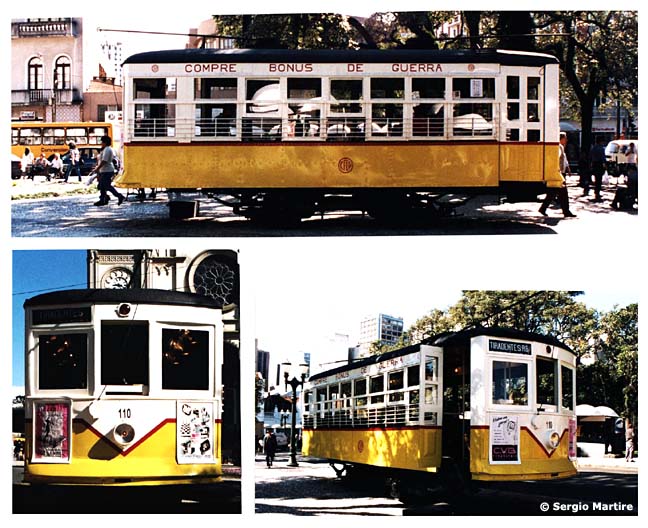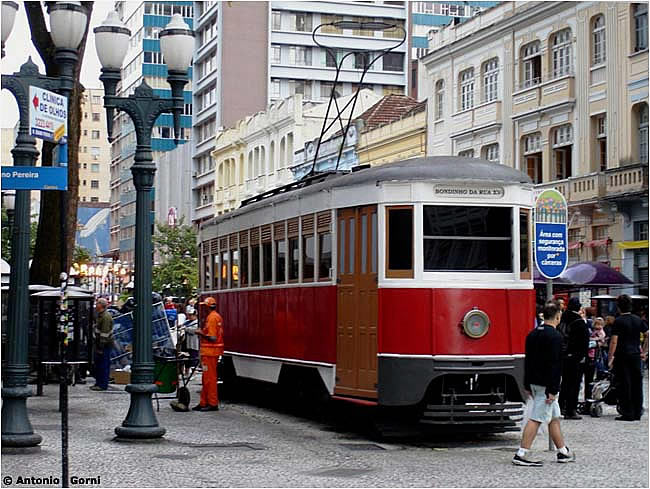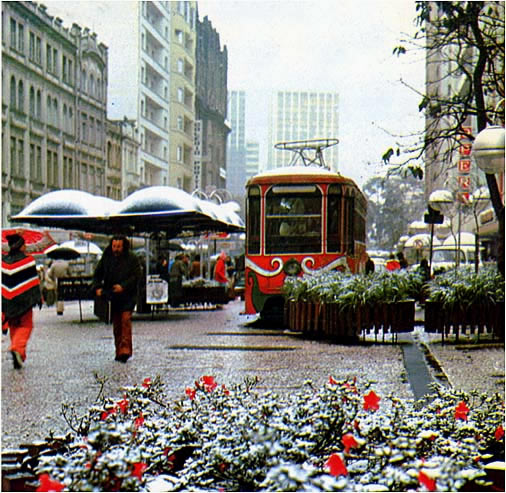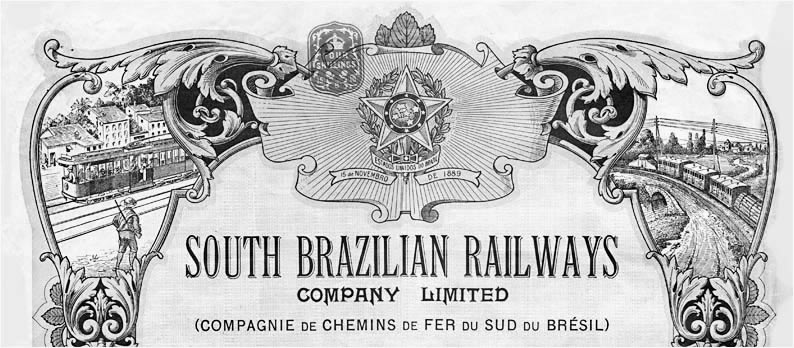
The Tramways of CURITIBA Paraná state BRAZIL BY Allen Morrison [ Veja versão em português ]
Curitiba is the capital of Paraná, the state just south of São Paulo. (Paraná is also the name of a city in Argentina and the name of a river that flows into Argentina from Brazil.) The city of Curitiba sprawls on an escarpment at altitude 932 m, 100 km from the Atlantic port of Paranaguá. It is the only state capital in Brazil that has significant snowfall. Population was about 40,000 in 1900, was 300,000 in 1950 and is around 1.8 million today. Tramway development was international. A Brazilian named Boaventura Clapp acquired a franchise in 1883 to build a street railway and founded the Empresa Ferro Carril Curitybano. EFCC inaugurated its first line, from the railroad station on Av. 7 de Setembro to Batel [see map], on 8 November 1887. (The steam railroad from Paranaguá had arrived in 1885.) Clapp sold the EFCC in 1895 to Amazonas & Companhia, which was managed by an Italian named Santiago Colle. When this tramway ticket was issued in the 1890s there were 20 cars operating on 18 km of track [Julio Meili, Das Brasilianische Geldwesen, vol. 3, Zürich, 1903]:
The photograph below is said to show the inauguration in 1887. But that cannot be correct: (1) the tram is signed "FONTANA", which was not the first line to run [see map]; (2) the vehicle looks already worn out; (3) women did not wear their hair in pompadours until the 1890s. This picture was taken in the 1890s or early 1900s [Prefeitura Municipal de Curitiba. Roteiro da Cidade: Do bonde de mula ao ônibus expresso. Curitiba, 1973, p. 7; reproduced with permission]:
Here is another undated photograph showing an unnumbered tram on the extension of the Batel line to Seminário [see map]. EFCC track gauge was a very narrow 700 mm [col. Cid Destefani]:
This postcard view of EFCC tram 5 was taken about 1900. The Grande Hotel was located at the corner of Ruas 15 de Novembro and Barão do Rio Branco [see map]. Note men on the roof [col. AM]:
In 1910 Colle sold the EFCC to a Frenchman named Eduardo de la Fontaine Laveleye, who was one of the founders of South Brazilian Railways in London (see certificate at top of page). The new Anglo-French company took over operation of the Curitiba tramway and hired Brown, Boveri & Cie in Baden, Switzerland, for electrification. In 1911 SBR ordered 29 electric trams from Les Ateliers Métallurgiques in Nivelles, Belgium. They were convertible models with removable sides, unique in Brazil [col. AM]:
The new trams arrived at Paranaguá in April 1912 and began testing in Curitiba the following August. The car below is in jardinière (summer) mode [col. AM]:
SBR inaugurated electric tramway service in Curitiba on 7 January 1913. The new Belgian cars had trolley poles that swiveled to reach wires hung along the side of the street, an arrangement that was unique in South America. Here is the terminus of the Portão line about 1914 [see map]. Track gauge of the electric tramway was one meter [col. AM]:
This Belgian tram was photographed in 1916 on Av. João Gualberto on the Bacacheri line, on the other side of town [see map] [col. Cid Destefani]:
The city took over South Brazilian Railways in 1924 and both the tramway and electric utilities passed in 1928 to the Companhia Força e Luz do Paraná, a subsidiary of the U.S. conglomerate Electric Bond & Share. The photograph below was taken about 1928 at Praça Osório [see map]. The tram is signed "SIQUEIRA CAMPOS" [col. Cid Destefani]:
The new North American owners placed fleet numbers on the Belgian trams for the first time. Here is CFLP 25 on the Trajano Reis line [see map] about 1932 [col. Cid Destefani]:
In 1931 CFLP imported 20 "Birney" cars second-hand from Boston, U.S.A., which had been built by J. G. Brill in Philadelphia in 1920. In 1937 it transferred 10 Birneys to Curitiba from its tramway in Porto Alegre, which had been built by Brill for Baltimore in 1921. The trucks of all 30 trams had to be reconstructed for Curitiba's meter gauge. Number 102, below, from the Boston group, was photographed at Praça Generoso Marques (where Rua Riachuelo meets Rua Barão do Rio Branco on the map) [col. Cid Destefani]: 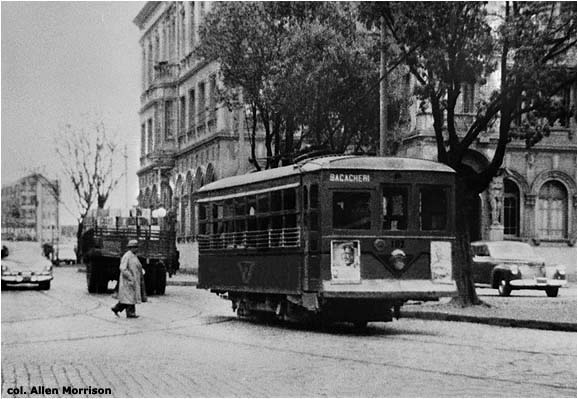 |
Two Birney trams cross Praça Tiradentes in 1934. View is northwest [see map] [col. Cid Destefani]:
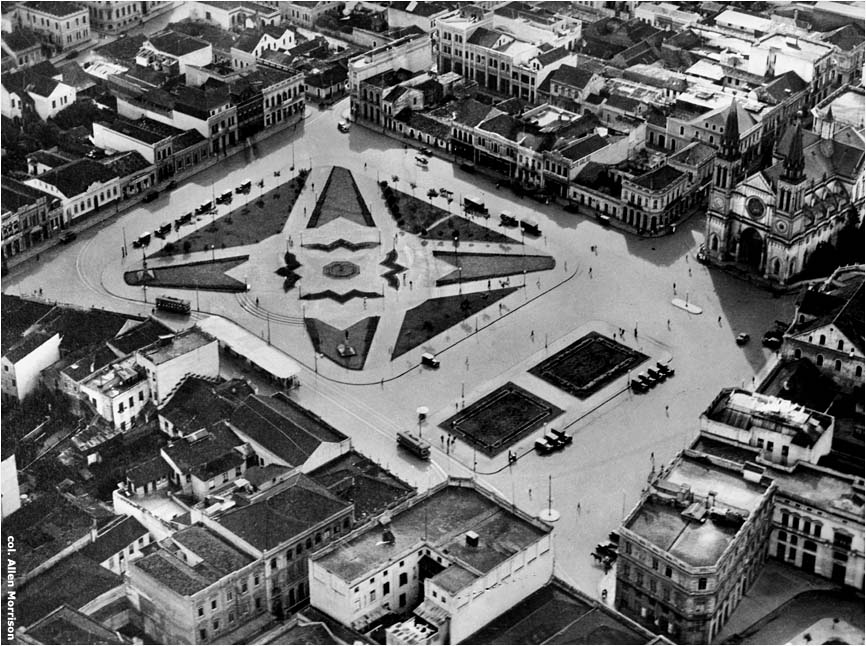
In 1945 CFLP sold its 38 passenger trams and 28 km of track to a new municipal agency, Companhia Curitibana de Transportes Coletivos. This photograph of a streamlined car, probably a rebodied Birney, was taken in 1951 [E. C. Piercy]:
The other end of the same tram a short while later [photographer unknown]:
Curitiba grew rapidly in the 1930s and 40s but did not modernize its tramway system. A primitive network of single-track lines with 2-axle cars, all decades old, was no longer adequate. CCTC began to replace its trams with buses during the Second War: first on the Batel line, then Bacacheri, then Guabirotuba, then Trajano Reis [see map]. By 1952 only the Portão service remained. The picture below shows one of the last tram trips – perhaps it was the last? – on Av. República Argentina [col. Cid Destefani]:
A Birney on the Portão line ended tramway service in Curitiba in July 1952. Curitiba was one of the first Brazilian capitals to close its tramway system (Belém and Fortaleza had eliminated rail service in 1947). The Belgian trams were apparently scrapped, but Birney tram 110 somehow survived in the back of a garage on Rua Barão do Rio Branco – the site of the former carbarn. It was restored and placed on display on Praça Tiradentes in November 1999 [see map]. The photograph below was taken in January 2002. The "CFLP" logo is barely legible on the side of the car [Sergio Martire]:
Unfortunately, tram 110 was removed from Praça Tiradentes in 2003 and is now in storage. The best known tram in Curitiba today is a car built for Santos, number 206, that was brought to Curitiba in 1973 and has been displayed for three decades on Rua 15 de Novembro [see map]. [A photograph on The Tramways of Santos page shows identical tram 280.] The "Bondinho da Rua XV" has served various functions in Curitiba and presently is an information office for visitors [Antonio Gorni]:
Rua 15 de Novembro on a snowy day in 1980 [postcard, col. AM]:
Among city planners and transport developers Curitiba is world renowned for its pioneer reserved-lane bus system. Thanks to the efforts in the 1960s of Curitiba architect-mayor-governor Jaime Lerner, Curitiba inaugurated a network of express bus lanes in 1974 that served as model for reserved-lane networks in São Paulo and other Brazilian cities in the 1980s, the reserved-lane trolleybus system in Quito, Ecuador, in 1995, and the TransMilenio express bus system which opened in Bogotá, Colombia, in 2000. In 1996 the United Nations Conference on Human Settlements (Habitat II) praised Curitiba as "the most innovative city in the world". Over the years various attempts have been made to replace Curitiba's bus lanes with light rail, monorail or heavy-rail metro [see references below]. But so far the canaletas exclusivas are still used by diesel buses.
BIBLIOGRAPHY Untitled news item. Brazil-Ferro-Carril (Rio e Janeiro), 4/1911. Arrival at Paranaguá from Europe of electric trams and 714 other boxes of electric materials for the South Brazilian Railway Co. Ltd. British Chamber of Commerce of São Paulo & Southern Brazil. The State of Paraná: An Official Handbook. São Paulo, 1930. Brief description of the Curitiba tramway, pp. 98-99. Livro Azul - Guia Azul. Curitiba, 1935. Fold-out street map shows tramway system in detail. Prefeitura Municipal de Curitiba. Roteiro da Cidade: do bonde de mula ao ônibus expresso. Curitiba, 1975. Fine 36-page booklet describes city's transport history, from horsetrams to express buses in segregated lanes. Eight large photographs of trams and buses. "Nas vias do expresso, o bonde de mula" in O Estado do Paraná (Curitiba), 29/3/1980, p. 14. Full-page survey of Curitiba's tramway history. Fourteen illustrations. "O transporte de massa, do bonde ao articulado" in O Estado do Paraná (Curitiba), 2/11/1980. Long, half-page history of the city's urban transport. "Os bondes de Curitiba" in Isto É (São Paulo), 4/8/1982. Full-page article about light rail plans in Curitiba. Photo of Birney in the 1940s. Waldemar Corrêa Stiel. História do Transporte Urbano no Brasil. Brasília, 1984. Curitiba chapter, pp. 102-115, describes history of the city's tram and bus systems. Eleven illustrations. "À espera do bonde (e do dinheiro)" in Revista Ferroviária (Rio de Janeiro), 4/1989, pp. 30 & 32. Long article about Curitiba's light rail project. Map, vehicle diagram and picture of Mayor Jaime Lerner. "Obras do metrô começam no ano 2000" in Gazeta do Povo (Curitiba), 3/9/1998. Long article about plans for 15-km heavy rail line; says construction will begin in 2000. Engenharia Viária: Estudos para a implantação do metrô de Curitiba (monorail). Description of Esteio monorail project, 1999. Curitiba poderá ter metrô leve nas canaletas de ônibus. Plan to build light rail lines in express bus lanes, 2003. Bondes podem voltar a circular em Curitiba. Newspaper article about a plan to install a "Bonde Turístico" line in the city center. Map and comments by readers, Adriano Justino. O Último Bonde in Gazeta do Povo (Curitiba), 20/4/2013. Update on Birney 110, presently stored under a shelter of the local transportation company, Urbanização de Curitiba S/A) ("URBS"), in the Tingui district. Link to excellent video.
I wish to thank Curitiba resident Cid Destefani for supplying many of the extraordinary early images shown on this page. In addition to his translation into Portuguese of my original English text, I also want to thank Mauricio R. Ortega for identifying some of the locations shown in the photographs.
Veja versão em português See my index of If you have comments, criticism or suggestions, This site was placed online on Copyright © 2007-2107 Allen Morrison |
